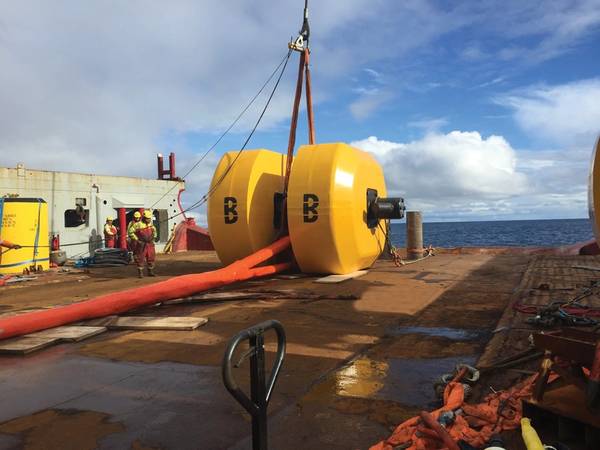
Aberdeen-based Balmoral has developed mooring buoyancy for the offshore wind and SURF sectors.
"A comprehensive range of ‘off-the-shelf’ products are deployed across a number of applications, from simple location markers to short term installation/deployment aids, while specialized mooring buoy arrangements bring unique characteristics and advantages to the floating wind and SURF markets," Balmoral, which has a long track record of buoyancy installations around the world.
Balmoral’s in-line mooring buoyancy system is designed to secure floating wind turbines and other structures to a seabed anchor whilst providing uplift to the mooring line. It can also act as a connection point between the bottom and top sections of the line while allowing trajectory and tension to be controlled within the water column.
Traditional mooring systems feature a pendulum fixture using a tri-plate and buoyancy module secured via a padeye at the base of the steelwork which gives an offset centre of buoyancy.
Balmoral’s engineers identified the biggest vulnerability of this system was fatigue failure due to the offset loads so, to mitigate against this and change the load transfer characteristics, developed a proprietary in-line mooring buoy.
The company’s in-line system features a dynamic connection interface that allows the different sections of the mooring lines to be tethered securely and responsively without adversely loading the buoyancy structure.
Central steelwork passing through the dynamic connection, with buoyancy elements mounted on either side, results in the key interface between components being at the center of the assembly.
This, according to Balmoral, brings a number of unique advantages that include movement minimization, buoyancy load transfer isolation, fatigue reduction, and a distinctly more stable solution for floating wind turbines, FPSOs, and other subsea tether connections.
The company’s engineering manager, Craig Sharp, said: “Our robust design process considers the combination of material characteristics and associated design controls, derived from detailed analysis, which allows us to supply the most cost-effective and fit-for-purpose solution.
“Our in-line mooring solutions are designed in accordance with all relevant industry standards, while we have also worked hand-in-hand with clients to deliver their third-party approved designs across a number of projects.
“As they are provided in modular fashion our mooring buoyancy systems can be configured to suit specific project uplift requirements.”
According to Balmoral, in-line mooring buoyancy benefits are:
•Lower number of components and connections
•Increased reliability with fewer potential failure points
•Reduced risk of wear
•Decreased dynamic loads on mooring points compared to traditional pendant line connection
•Improved fatigue life characteristics
•Easier handling with lift points acting through the centre of mass eliminating unwanted bending loads
•Enhanced access to mooring connections for inspection during service life
Balmoral’s buoyancy, protection and insulation products will be on display on stand 3D30 at Offshore Europe in Aberdeen, 5-8 September.